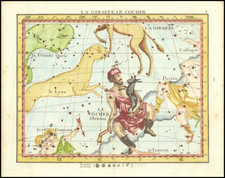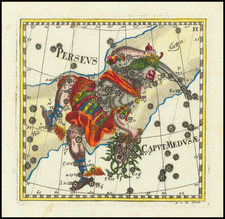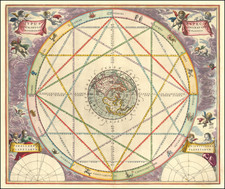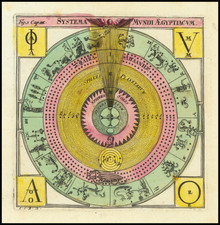One of the “The Seven Liberal Arts”
Rare allegorical astrological image, by Frans Floris and Hieronymus Cock.
The title translates as: "Uranium consults the various recourses with eyes and mind to foresee the future."
A winged female figure with her head encircled by the stars shown at center, with one arm pointed toward the stars, while she rests on a large celestial globe. Her breastplate illustrates the sun, moon, and stars, with books and astrological tools are on the ground at her feet. The books include the works of Anaximenes, Hyginus, Manlius, Pontanus and Ptolemaus, each of whom wrote on various celestial, astronomical and astrological topics in ancient times.
The map was originally published in Antwerp by Hieronymus Cock. In this state of the image, Cock's name to the right of the celestial hemisphere in the dark area has been mostly removed, although the K is still visible.
The image is based upon a painting by Antwerp artist Frans Floris (1519/20-1570), the foremost Antwerp artist of the mid-sixteenth century, sometimes called the Flemish Raphael. As a result of his close relationship with the publisher Hieronymus Cock, who established the Quatre Vents press in the same years that Floris started to receive important commissions, a number of his paintings were later published as engravings by Cock.
The image is one of a set of seven images illustrating the seven liberal arts: Grammar, Rhetoric, Dialect, Arithmetic, Geometry, Astrology and Music.
Hieronymus Cock (1518-1570) was a skilled Flemish engraver, painter, and publisher of prints in the sixteenth century. He hailed from an artistic family, as his father and brother were both painters as well. He trained as a painter in Antwerp and then spent time in Rome (1546-7).
Cock and his wife, Volcxken Diercx, established their publishing house in 1548 at Aux quatre vents, or at the house of the four winds. Cock’s publishing house became renowned in northern Europe as he and his wife, and successor, transformed printmaking from an individual activity to one based on a division of labor. This allowed him to publish more than 1,100 prints in just over two decades (1548-1570). He is known to have personally etched 62 plates.
Cock’s cartographic output included country maps, landscape prints, and town plans, especially of cities under siege. He also worked with mapmakers; for example, he collaborated with Diego Gutiérrez on a 1562 map of the America. He famously released prints by important engravers who produced works after the Italian masters of the Renaissance, popularizing that movement in the north of Europe.









![[Pegasus, Delphinus, Equueleus]](https://storage.googleapis.com/raremaps/img/small/91233.jpg)




![[ Exceptional original hand-color with highlights in gold ] Typus Aspectuum Oppositionum Et Coniunctionum Etz In Planetis](https://storage.googleapis.com/raremaps/img/small/81866.jpg)